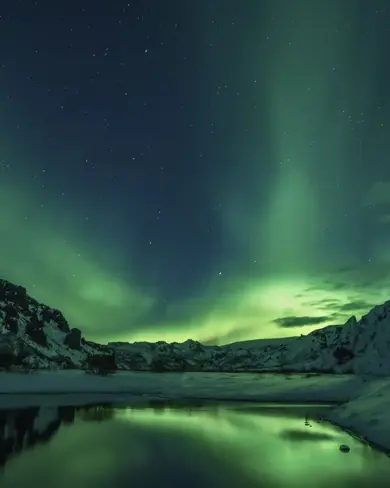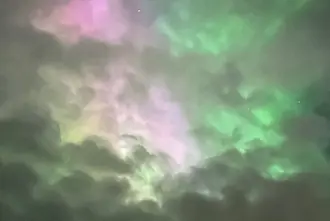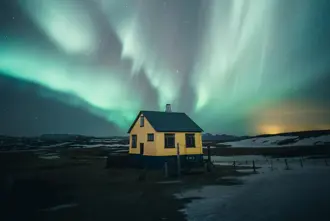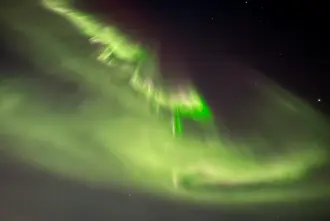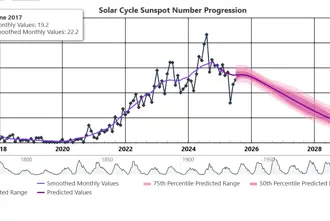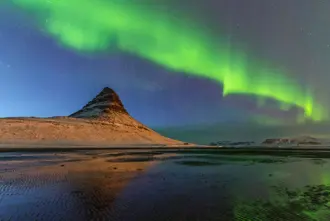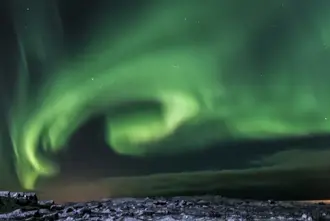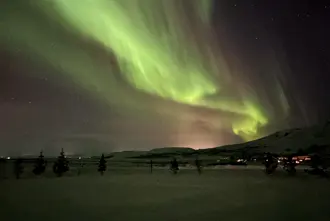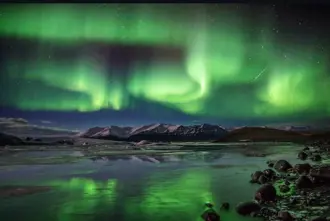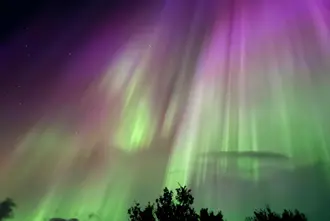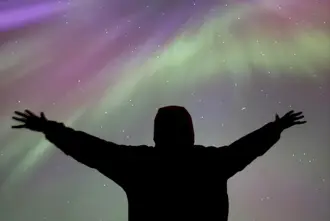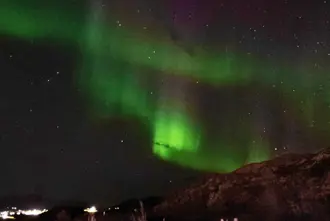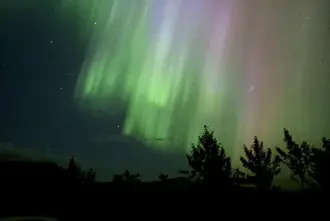2025 is the Best Time for Northern Lights in Iceland
Travelers in Iceland agree that 2025 is the best time for the Northern Lights. Right now Reddit and Social Media are blowing up with travelers' Northern Lights photos and some are seeing their first ever aurora borealis thanks to the Solar Cycle 25.
Discover the Auroras
on a 5-Day Northern Lights Hunt
Travelers Sven and Gloria Anderson were happy to share a photo and a few words with us from their trip outside of Reykjavik.
"We took an organized tour which was a fun way to chase the lights together! We saw them 45 minutes outside of Reykjavik where it was very dark!" - Sven and Gloria Anderson from Oregon, USA, captured September 2025 on an organized tour.
Aron, a photographer in Iceland, has also been taking advantage of the northern lights season in Iceland this year and shares his aurora photos on Reddit.
Travel bloggers have also been rushing to Iceland to make the most of the season and Marion was one of them that joined an evening northern lights hunt in March 2025 and said
"It was a bucket list moment that I was so happy to finally check off! It was a very cold day and still winter in Iceland with a lot of nighttime hours, giving us a great chance to see them."
While one of many reddit users described his 2025 experience in more detail:
If I'm honest, I didn't know what to expect. Every aurora picture I'd seen before hand, and all videos, I assumed were doctored in some way (videos for speed, pictures for vibrancy), but boy was I wrong. There we were, stood in the dark, me with no gloves or hat (because I'd stupidly left without them), but not feeling the cold - just taken in by the majesty of it all." - Reddit AdWerd1981, captured February 2025 on a Northern Lights Tour at Þingvellir National Park, Iceland.
Travelers are seeing the lights all over Iceland but the question remains why is the best time to see the auroras in Iceland right now?! Let's first find out...
...what makes 2025-2027 so great for the northern lights in Iceland?
Solar Cycle 25 - The 11-Year Solar Cycle High
Earth’s Sun isn’t constant. Every ~11 years it cycles from a calm phase to a magnetic-chaos phase we call solar maximum. Solar Cycle 25 is the current cycle (it kicked off around December 2019), and it’s now in full swing. In fact, scientists initially forecasted this cycle’s peak to hit in mid-2025 with about 115 sunspots at maximum. Fast forward to now, and those sunspot counts have already blown past expectations – the Sun is even more active than predicted.
“Solar Cycle 25 sunspot activity has slightly exceeded expectations,” notes Dr. Lisa Upton, co-chair of NOAA’s Solar Cycle Prediction Panel. For aurora lovers, that is very good news!
Solar Cycle 25 sunspot number progression and forecast. Higher sunspot numbers (vertical axis) mean a more active Sun. The purple line shows the predicted trend, peaking around 2024–2025, with observed activity (black line) running on the high side of predictions.
Just look at the chart above. The spike around 2024–2025 shows we’re at the solar maximum now, which is the Sun’s high-energy “stormy” season. During solar maximum, the Sun’s surface is freckled with dark sunspots – cooler magnetic blotches that serve as launch pads for solar flares and CMEs (coronal mass ejections).
“During solar maximum, the number of sunspots – and therefore the amount of solar activity – increases,” explains NASA space weather program director Jamie Favors.
More sunspots = a livelier Sun. And a livelier Sun means more chances for the kind of solar outbursts that light up our skies.
Not only is Solar Cycle 25 active, it's turning out to be one of the strongest cycles in decades. In August 2024, the daily sunspot index hit 337 – a level not seen since 2001! NOAA and NASA scientists monitoring the cycle were pleasantly surprised to see such high activity. (To put that in perspective: the last solar cycle peak in 2014 barely reached ~116 sunspots, so this cycle is way more feisty.) Little wonder experts are happy that we might be heading into “one of the best cycles in recent decades for aurora watchers,” as researchers have been saying.
More Solar Storms Means More Auroras in 2025
So what do sunspots and solar storms have to do with the Northern Lights? In a nutshell: the aurora is Earth’s neon sign that the Sun is acting up. When the Sun erupts – tossing out flares or blobs of charged plasma (CMEs) – it sends a rush of electrically charged particles hurtling toward Earth. When those particles slam into our planet’s upper atmosphere, they excite the gases up there and make the sky glow in ribbons of green, purple, and red. In other words, a solar storm at the Sun means a light show for us. And right now, the Sun is stormier than it’s been in a long time.
Because Solar Cycle 25 is at peak intensity, these solar storms are happening frequently.
“When the Sun is most active, space weather events become more frequent,” NASA notes – and indeed this heightened activity “has led to increased aurora visibility” in recent months.
Even places much farther from the Arctic Circle have been catching surprise auroral displays. One NASA report highlighted that a barrage of solar flares and CMEs in early May 2024 created the strongest geomagnetic storm in two decades – and possibly one of the most intense aurora displays of the past 500 years. That mega-storm lit up skies from Britain to New Zealand, places way out of the usual reach of the Aurora Oval. It’s a perfect example of how an active Sun translates into jaw-dropping auroras on Earth.
And there’s more to come.
“We’re anticipating another year or so of maximum phase before we really enter the declining phase,” Dr. Upton said in late 2024.
Translation: through 2025 (and into 2026), the Sun will keep flinging plenty of solar storms our way. NOAA’s experts agree – they’ve noted that the Sun has entered the peak of Cycle 25 and this high-energy stretch will last into 2026, boosting the chances of auroras creeping farther south than usual. In other words, not only will the usual aurora hotspots (like Iceland, Norway, Alaska, etc.) get more frequent and vibrant displays, but even lower-latitude places that rarely see the Lights might get lucky on strong storm nights. During one autumn 2025 storm, for instance, space weather forecasters watched the Kp index (a gauge of geomagnetic activity) surge to levels that can paint the aurora across U.S. states like Oregon and Illinois!
Of course, even the best parties wind down eventually. Solar Cycle 25 will likely start calming down in 2027, as the Sun slides into the quieter part of its cycle. But here’s an exciting tidbit: sometimes the declining phase of a solar cycle still delivers a parting gift or two in the form of major aurora storms that can last over a significant period. So, 2027 isn’t too late either.
The message is clear: now through the next couple of years is the sweet spot.
Why Iceland is The Best Place For the Northern Lights Right Now (2025-2027)
Okay, so we’ve established that the Sun is practically in party mode until 2027 — but not every location on Earth gets invited to the VIP viewing area. That’s where Iceland shines.
The Northern Lights don’t just appear randomly; they’re shaped by something scientists call the auroral oval — an invisible ring of light centered around Earth’s magnetic poles. Think of it like a glowing donut around the Arctic, and if you stand under that donut hole, your odds of seeing auroras shoot way up. NASA explains it like this:
the aurora “generally occurs in a band called the auroral oval” that expands equatorward during solar storms.
Now here’s the magic: Iceland sits smack in the middle of the auroral oval most of the year. That means travelers here don’t need a once-in-a-lifetime solar storm to see the lights. Even on “average” aurora nights, Iceland is in prime position. And during big solar events (which we’ll be getting plenty of through 2025–2027), the oval expands southward — but Iceland stays right at the heart of the action. Even travel companies are recommending Iceland as a prime destination for aurora chasers:
"Iceland has a front row seat, sitting directly above the auroral oval. Combine long winter nights and low light pollution in country districts, and it becomes one of the surest places to see the lights. In simple words, the coming few years are one of those rare sweet spots where science and setting coincide perfectly." - John William, Travel Advisor at Easy Travel And Tour Ltd
"The combination of its position close to the Arctic Circle and low levels of light pollution beyond Reykjavik offers travelers a front-row seat. Odds are further enhanced by long winter nights and clear and crisp skies. The results of solar activity are already being felt lately. We have witnessed mind-blowing auroras in 2024, and that is not all. There will be an increase in frequency and intensity." - Shariq Khan, Founder & CEO at Travelosei
Another advantage? Latitude. Many places on Earth are either too far north (like the High Arctic, where cloud cover and polar darkness can be extreme) or too far south (where you only see auroras during the strongest storms). Iceland hits that sweet spot — high enough to be under the oval, but not so high that you’re dealing with months of total darkness or unlivable cold.
NOAA puts it simply: the most reliable aurora viewing is “within the auroral zone,” typically between 65° and 75° magnetic latitude — and Iceland? It’s right there.
So when you combine:
- Solar Cycle 25’s peak activity (lots of auroras everywhere), and
- Iceland’s location inside the auroral oval (lots of auroras reliably)…
…it’s the worlds best northern lights recipe and travelers are not disappointed!
Reddit and Social are Blowing Up with Iceland's Northern Lights
Travelers have been sharing their stories with us all year from customers joining our tours to adventurers on social and reddit. They have not been disappointed with these powerful light shows caused by increased solar activities and agree that now is the best time to see the Northern Lights in Iceland. Here are just a few of their photos and experiences.
"Beautiful clear sky, really calm cold snap right before the red warning came a few days later! It was -12 this night. There was crisp deep snow everywhere which dampened all sounds. The campsite was almost empty. The Aurora forecast wasn’t great but then the numbers began creeping up earlier that evening. I was on the edge of my seat in anticipation, hoping I would finally get to see the lights on my third trip to Iceland! And it couldn’t have been more perfect.
I was all layered up and cozy but after a while my neck hurt from looking up. Eventually I decided to lay down right there in the snow and stare up at the sky. The incredible show went on from 7pm and was still going when I took a last peek hours later. It was the most unforgettable night." - Espg22 Reddit, captured January 2025 at the Golden Circle.
"I'm always exceptionally unlucky with aurora spotting - I've seen some fantastic aurora when I've been busy doing other things, but whenever I'm out hunting on purpose & with camera gear barely a peep!" - Alex France, captured at Jökulsárlón in Iceland.
"It’s been cloudy the last few days but last night we got the call from reception. Northern lights! Not the best photos but so amazing to finally see them." - Reddit Future-Cranberry-360, captured March 2025 in Vík í Mýrdal.
"Second time seeing the northern lights in under seven days. Iceland has been amazing to me." - Tknebg Reddit, captured September 2025 in West Iceland.
"I saw the Northern Lights in late March of this year in the city of Akureyri, on a hill overlooking the city at around 12:30 AM. The experience was breathtaking to say the least." - Aaron Wertheimer, Copywriter at Marketing-Reel.
"The one and only time I’ve ever seen the aurora - September 1 2025 outside our farm stay near Hvolsvollur!" - Outrageous Reddit, captured September 1st in South Iceland.
"Just decided to post some pictures from our August trip. We saw them on 20/08 while staying at a crib near kirkjubaejarklaustur. Our place was on a remote grass field, it was very dark, no light pollution, and it seemed like everybody was sleeping from the nearby houses. It couldnt be more perfect, we stayed up to 3 AM, until we were very tired and went for sleep totally happy :) " - Throwawaywolf123, captured August 2025 in South Iceland.
The Adventure Awaits!
Book Your 5-Day Northern Lights Hunt
Sources
NASA. (2023, December 11). Solar cycle 25 and space weather. NASA. https://science.nasa.gov/solar-cycle-25-and-space-weather/
NASA. (2023, December 14). Solar cycle progression and forecast. NASA. https://www.nasa.gov/solar-cycle-progression-and-forecast/
NOAA Space Weather Prediction Center. (2025). Solar cycle progression. NOAA National Centers for Environmental Information. https://www.swpc.noaa.gov/products/solar-cycle-progression
NOAA Space Weather Prediction Center. (2024, December 15). Solar Cycle 25 update. National Oceanic and Atmospheric Administration. https://www.swpc.noaa.gov/news/solar-cycle-25-update
NASA. (2024, May 16). Historic geomagnetic storm lights up the sky. NASA. https://science.nasa.gov/solar-physics/historic-geomagnetic-storm-lights-up-the-sky/
NOAA Space Weather Prediction Center. (2024, May 15). Strongest geomagnetic storm in two decades observed. National Oceanic and Atmospheric Administration. https://www.swpc.noaa.gov/news/strongest-geomagnetic-storm-two-decades-observed
